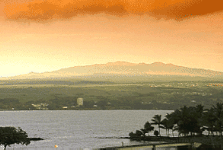Location
The Hawaiian Islands are located just south of the Tropic of Cancer in the Pacific Ocean, 2,400 miles southwest of California. The Big Island of Hawaii is the largest in the chain, roughly twice the size of all the other islands combined. It is also the southernmost island in the Hawaiian Islands chain.
Geology
The Hawaiian islands were all formed by volcanic activity on the ocean floor of the Pacific. Each island is essentially a mountainous volcano or group of volcanoes that has risen above the surface of the ocean and expelled lava to create land mass. The Big Island is the youngest of the Hawaiian Islands and is home to an active volcano, Kilauea. About 30 miles southeast of the Big Island, a new island, Loihi, is being formed. It is still about 3,000 feet underwater, but is expected to be the next island to emerge in the archipelago.
History
Before annexation to the United States, Hawaii was once an independent kingdom. Each island was a separate domain until 1795, when the first King Kamehameha united all of Hawaii. The charismatic Kamehameha and a dynasty of his progeny ruled the islands for the next century.
However, by the time King Kamehameha I died in 1819, Hawaii's socioeconomic system was already undergoing dramatic changes. Many of the ancient customs of the traditional "kapu" system were overthrown, and the burgeoning whaling industry and the missionionary movement were beginning to alter the islands' former way of life.
Hawaii slowly became populated by mainlanders trying to make money off of the islands' natural riches. And as in many parts of the world, the indigenous traditions of the Hawaiian islands ultimately gave way to sometimes violent pressures from missionaries, to be replaced by Catholicism and Christian morality.
By the late 19th-century, the United States was actively involved in shaping the islands' politics. Although the majority of Hawaiians opposed annexation, President McKinley signed an annexation agreement on July 7, 1898. Hawaii was finally granted statehood on August 21, 1959.
The Kona Historical Society is a good place to get further information about the Big Island's cultural past.
Weather
The east side of the island is often wet from the moist trade winds coming from the northeast. The island's western side, on the other hand, is drier and is the location of most of the hotels and resorts. Average temperatures on the Big Island range from 66 to 88 degrees Fahrenheit. Nights get a bit cooler, so a sweater comes in handy. You can call 808-961-5582 for current weather conditions.
When To Go
Any time is a good time to visit the Big Island. Accommodations are usually cheaper between April and mid-December.
The People
The Big Island's population is 130,500. It's roughly 26 percent Hawaiian and part-Hawaiian, 25 percent Caucasian, 21 percent Japanese, and 28 percent Filipino and other Asian and Pacific Islanders.
Although contemporary culture in Hawaii is similar to that of the rest of the U.S., Hawaiians strive to preserve cultural traditions. Language and hula classes are common, and traditional arts and crafts thrive. The social tradition of giving flower necklaces, or leis, illuminates the richness of the Hawaiian culture. Different leis have different meanings. For example, tourists are given leis of plumeria, while a bride might wear a lei of pikake. There are special leis for hellos and good-byes, and each island has its own particular lei.
Cuisine
Hawaii's sizable Asian influence is evidenced by much of the islands' cuisine. A typical "mixed plate" for lunch comes with rice and macaroni salad, as well as your choice of an Asian dish such as chicken teriyaki (Japanese), beef with oyster sauce (Chinese), or kalua pig (Hawaiian). Kalua pig, a favorite of luaus, is a suckling pig slow-cooked in an underground oven. Dried salted fish is also a favorite, as is poi, a stew made from the taro plant. Indigenous fruits such as star fruit and breadfruit are used in many traditional recipes.
For dessert, try a local favorite, shave ice--it's like a snow cone but even better. Or, sink your teeth into some chocolate-covered macadamia nuts, available at nearly every drugstore, grocery store, and souvenir shop.
Calendar of Events
- February
Mardi Gras: Held in Hilo, this colorful celebration is a smaller version of the Mardi Gras held in New Orleans.
- March
Pele's Cross-Country Ski Cup at Mauna Kea: This four-day competition--the only place in Hawaii where you can actually ski--is just one of several ski events held on the island between February and May.
- April
Merrie Monarch Festival and Hula Competition: One of Hawaii's premier hula competitions, this annual event takes place in Hilo.
- June 11
King Kamehameha Day. This state holiday is celebrated with a parade, canoe races, and a crafts fair in Kona.
- July 4
Parker Ranch Rodeo and Horse Races: This large-scale event is staged in Waimea.
- October
Aloha Week: This is a statewide festival held in Wailuku with parades, dances, canoe racing, and sports.
Gatorade Ironman Triathalon
Annual Macadamia Nut Festival in Hilo
- November
The annual Kona Coffee Cultural Festival: Held in Kailua, the festival includes a bean-picking contest and tours of coffee farms.
Hamakua Taro Festival in Honokaa: This festival pays tribute to the root that has been a chief staple in the islanders' diets for hundreds of years.
HAWAII >>
Highlights |
What To Know |
Travel Tips |
Activities |
Attractions
|






